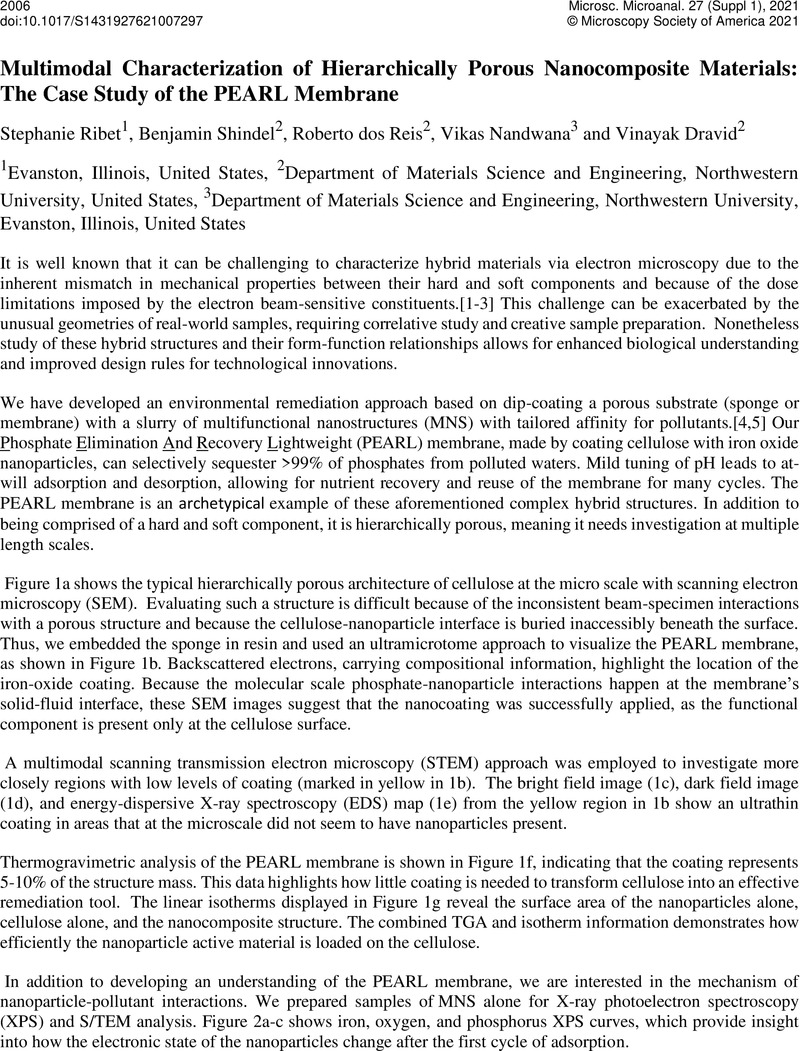No CrossRef data available.
Article contents
Multimodal Characterization of Hierarchically Porous Nanocomposite Materials: The Case Study of the PEARL Membrane
Published online by Cambridge University Press: 30 July 2021
Abstract
An abstract is not available for this content so a preview has been provided. As you have access to this content, a full PDF is available via the ‘Save PDF’ action button.

- Type
- Microscopy and Microanalysis for Real World Problem Solving
- Information
- Copyright
- Copyright © The Author(s), 2021. Published by Cambridge University Press on behalf of the Microscopy Society of America
References
Egerton, R. F. (2019). Radiation damage to organic and inorganic specimens in the TEM. Micron, 119, 72-87.CrossRefGoogle ScholarPubMed
Mayer, J., Giannuzzi, L. A., Kamino, T., & Michael, J. (2007). TEM sample preparation and FIB-induced damage. MRS bulletin, 32(5), 400-407.CrossRefGoogle Scholar
Ribet, S.M., Murthy, A. A., Roth, E. W., Reis, R. D., & Dravid, V. P. (2021). Making the Most of your Electrons: Challenges and Opportunities in Characterizing Hybrid Interfaces with STEM. Materials Today. Invited review article, under review.CrossRefGoogle ScholarPubMed
Nandwana, V., Ribet, S. M., Reis, R. D., Kuang, Y., More, Y., & Dravid, V. P. (2020). OHM Sponge: A Versatile, Efficient, and Ecofriendly Environmental Remediation Platform. Industrial & Engineering Chemistry Research, 59(23), 10945-10954.CrossRefGoogle Scholar
Ribet, S.M., Shindel, B., Reis, R.D., Nandwana, V., & Dravid, V.P. (2021). Phosphate Elimination and Recovery Lightweight (PEARL) Membrane: A Sustainable Environmental Remediation Approach. Under review.Google ScholarPubMed
Sousa, A. A., & Leapman, R. D. (2012). Development and application of STEM for the biological sciences. Ultramicroscopy, 123, 38-49.Google ScholarPubMed
The research related to oxide nanostructured architecture was initially supported by the National Science Foundation under Grant No. DMR-1929356 (Ceramics Program, PM: Dr. Lynnette Madsen). This work made use of the EPIC, BioCryo, and Keck-II facilities of Northwestern University's NUANCE Center, which has received support from the SHyNE Resource (NSF ECCS-2025633), the IIN, and Northwestern's MRSEC program (NSF DMR-1720139). Elemental analysis was performed at the Northwestern University Quantitative Bio-element Imaging Center. Nitrogen adsorption isotherm analysis was performed at the Northwestern Reactor Engineering and Catalyst Testing core facility.Google Scholar



